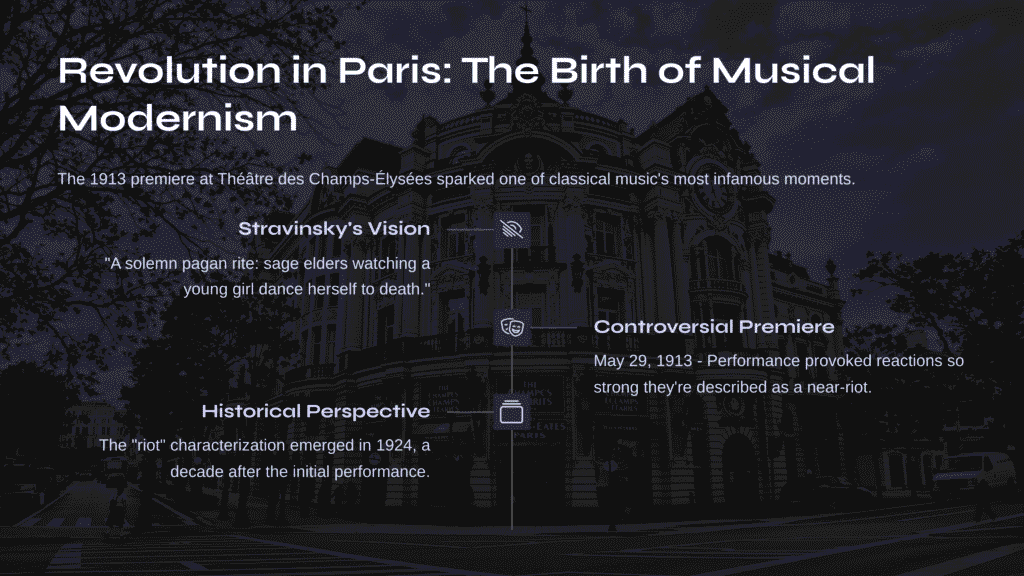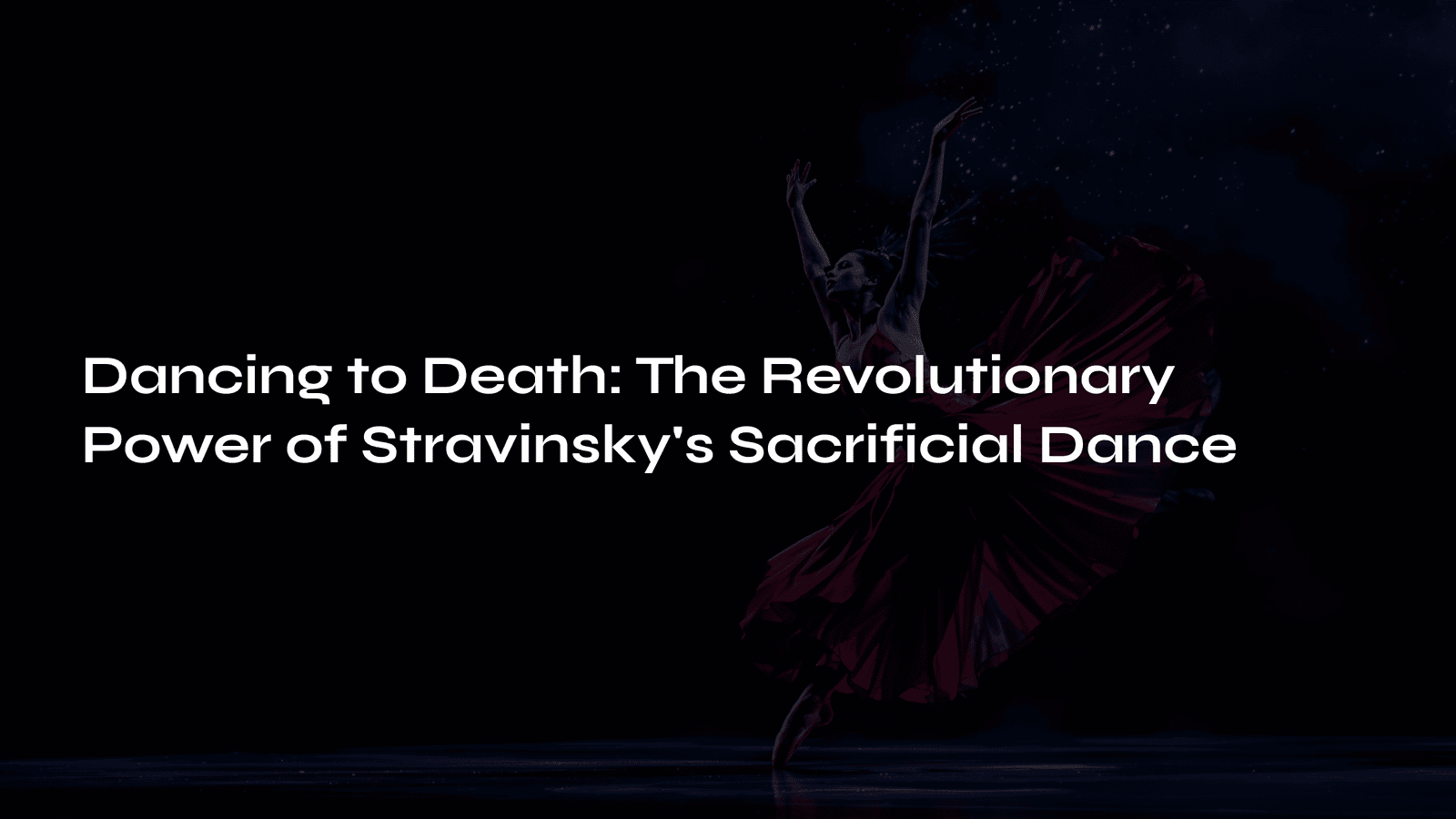Table of Contents

When Music Shook the World
I still remember the first time I heard it—that violent, pulsating rhythm cutting through the air like a primal scream. My body tensed, heart racing to match those erratic beats as Stravinsky’s Sacrificial Dance from The Rite of Spring reached its frenzied climax. This wasn’t just music; it was a force of nature, an artistic earthquake that continues to send aftershocks through our cultural landscape more than a century later.
The power of this piece lies not just in its notes but in its ability to transport us to somewhere ancient and primal—a place where art, ritual, and sacrifice intertwine. The music demands something from us as listeners, just as it demanded everything from its fictional sacrificial victim. It asks us to surrender to something larger than ourselves.

Revolution in Paris: The Birth of Musical Modernism
When Stravinsky’s ballet premiered on May 29, 1913, at the Théâtre des Champs-Élysées in Paris, it catalyzed one of the most infamous moments in classical music history. Though accounts vary (and have been embellished over time), the performance provoked a reaction so strong that it has been described as a near-riot.
Interestingly, the characterization of the premiere as a “riot” didn’t emerge until reviews of performances in 1924, more than a decade after the initial performance. Nevertheless, the work’s revolutionary nature is undeniable. Stravinsky himself described the inspiration for the ballet as a vision: “I saw in my imagination a solemn pagan rite: sage elders, seated in a circle, watching a young girl dance herself to death. They were sacrificing her to propitiate the god of Spring.”
The ballet unfolds in two parts: “The Adoration of the Earth” and “The Sacrifice.” The Sacrificial Dance concludes the second part, depicting the chosen victim dancing with increasing frenzy until she collapses in death—a ritual sacrifice to ensure the renewal of spring.

The Music of Sacrifice: Breaking All the Rules
The Sacrificial Dance represents the culmination of Stravinsky’s revolutionary approach to composition. If we listen closely, we can identify several elements that made this piece so groundbreaking:
Rhythm as Weapon
The most immediately striking aspect is the rhythmic structure. Stravinsky abandons traditional metric regularity in favor of constantly shifting accents and time signatures. This deliberate disruption creates a sense of disorientation and primal energy that mirrors the psychological state of the ritual sacrifice.
The irregular accents follow no predictable pattern, keeping listeners (and performers) in a state of perpetual tension. As Leonard Bernstein described it, the piece contains “the best dissonances anyone ever thought up, and the best asymmetries and polytonalities and polyrhythms and whatever else you care to name.”
Harmonic Violence
Stravinsky pairs his rhythmic innovation with harmonic language that was shocking for its time. Harsh dissonances and polytonal elements (the simultaneous use of multiple keys) create a sound world that breaks decisively with the lush harmonies of late Romanticism.
The final chord of the piece, which Stravinsky himself referred to disparagingly as “a noise,” brings the intense dance to a sudden, jarring halt. Despite multiple attempts to rewrite it, the composer couldn’t produce a more satisfactory solution—perhaps because its very unsatisfactoriness is what makes it so powerful.
Orchestration as Ritual
The orchestration of the Sacrificial Dance is equally revolutionary. Stravinsky uses the large orchestra not for lush, blended sounds but for stark, primitive effects. Instruments are often pushed to extremes of their ranges, creating timbres that sound raw and uncultivated.
In 1943, Stravinsky created a revised version that differed significantly from the commonly performed 1947 version. The 1943 version barred the majority of the piece in 8 instead of 16, making it easier to read and conduct. The orchestration is also sparser, with less brass, reduced use of alto flute, and modifications to the timpani part. Stravinsky claimed this new revision would “basically conduct itself,” though ironically, this version is rarely performed today.

The Dance of Death: Choreographic Interpretations
While the music alone is revolutionary, The Rite of Spring was conceived as a ballet, and the choreography for the Sacrificial Dance has evolved significantly over time, reflecting changing cultural perspectives on sacrifice, gender, and ritual.
Nijinsky’s Primal Vision
The original choreography by Vaslav Nijinsky was performed only eight times before being replaced in the 1920s by Léonide Massine’s version. Nijinsky’s choreography was long believed lost until reconstructed by the Joffrey Ballet in Los Angeles during the 1980s.
This reconstruction revealed deliberately awkward, almost grotesque movements that dramatically contrasted with classical ballet elegance. The dancers performed with turned-in feet and hunched postures, rejecting the ethereal lightness of traditional ballet in favor of something earthy and primal.
In the Sacrificial Dance, the chosen victim performs increasingly frenzied movements until collapsing in death. Though only four to five minutes long musically, the dance represents an extended suffering—a young woman condemned to death for the community’s benefit.
Pina Bausch’s Feminist Reinterpretation
Perhaps the most influential modern interpretation came from German choreographer Pina Bausch in 1975. Her version features a soil-covered stage and simple white costumes that become increasingly muddied throughout the performance. The chosen woman wears a distinctive red dress symbolizing blood and death.
Bausch’s choreography “places the emotional journey of the sacrifice in center stage—quite literally—with the movements beginning to break the dancer down as she violently throws herself into the exhausting sacrificial ritual.” Rather than being chosen randomly through ritual, Bausch has the women themselves decide who will be sacrificed to the men, adding layers of feminist commentary to the work.

Experiencing The Sacrificial Dance: A Listener’s Guide
When approaching this revolutionary piece for the first time (or the hundredth), here are some elements to listen for that will deepen your appreciation:
Focus on the Rhythm
Try to feel the destabilizing effect of the constantly shifting accents. Rather than fighting against the disorientation, surrender to it. The power of the piece comes partly from this sense of losing your rhythmic footing.
Follow the Crescendo of Intensity
Notice how Stravinsky builds tension throughout the short piece. The music becomes increasingly frantic, mirroring the dancer’s journey toward death. The orchestration gets denser, the dissonances more extreme, the rhythmic patterns more complex.
Listen for the Primitive
Hear how Stravinsky evokes something ancient and ritualistic through his use of repetitive motifs, stark instrumental colors, and percussive effects. This isn’t music that seeks to be beautiful in a conventional sense—it aims to tap into something deeper and more primal.
Compare Different Interpretations
Each conductor brings a different perspective to this challenging piece. Some emphasize the raw power, while others bring out structural clarity. Compare recordings by Pierre Boulez, Valery Gergiev, and Leonard Bernstein to hear dramatically different approaches.

The Cultural Echo: Why The Rite Still Matters
Over a century after its creation, why does the Sacrificial Dance continue to captivate us? Perhaps because it speaks to something fundamental about the human experience—the tension between individual and community, the concept of necessary sacrifice, and the transformative power of ritual.
The piece has been interpreted through various cultural lenses since its creation:
The original pagan/ritualistic concept depicted ancient pagan Russia and fictional ritual sacrifice.
Feminist interpretations like Bausch’s reframe the sacrifice within discussions of patriarchal power structures and female agency.
Anthropological analyses explore broader human questions about who is permitted to live and what merits sacrifice in different social contexts.
The work’s influence extends far beyond classical music, affecting dance, film scoring, and popular music. Each new performance and interpretation adds layers of meaning to this complex, profound work, confirming its status as one of the greatest artistic achievements of the 20th century.

The Lingering Power of Sacrifice
As the final, jarring chord of the Sacrificial Dance fades into silence, we’re left with the unsettling question at the heart of Stravinsky’s masterpiece: What does it mean to sacrifice? Whether we interpret the piece literally as a depiction of ancient ritual or metaphorically as a commentary on artistic innovation itself (Stravinsky sacrificing musical convention on the altar of modernism), the work continues to disturb and transform us.
The revolutionary power of this music lies in its refusal to comfort. It forces us to confront something wild, something untamed within ourselves and our collective cultural consciousness. In those violent rhythms and dissonances, we hear not just the birth of musical modernism but an eternal human truth about creation, destruction, and renewal.
The chosen victim dances herself to death, and in her sacrifice, spring—and a new artistic era—is born.
If You Loved This, Listen to This Next

If you were captivated by the primal power and revolutionary spirit of Stravinsky’s Sacrificial Dance, you might find yourself equally moved by Eternal Resonance: Bach’s ‘Mass in B Minor’ – The First “Kyrie eleison” – where profound spiritual depth and architectural complexity create a transcendent musical experience that represents another pinnacle of human artistic achievement.
Both works, though separated by centuries and vastly different in style, reveal how composers channeled the deepest human emotions into transformative music that continues to move listeners across time and cultural boundaries.



